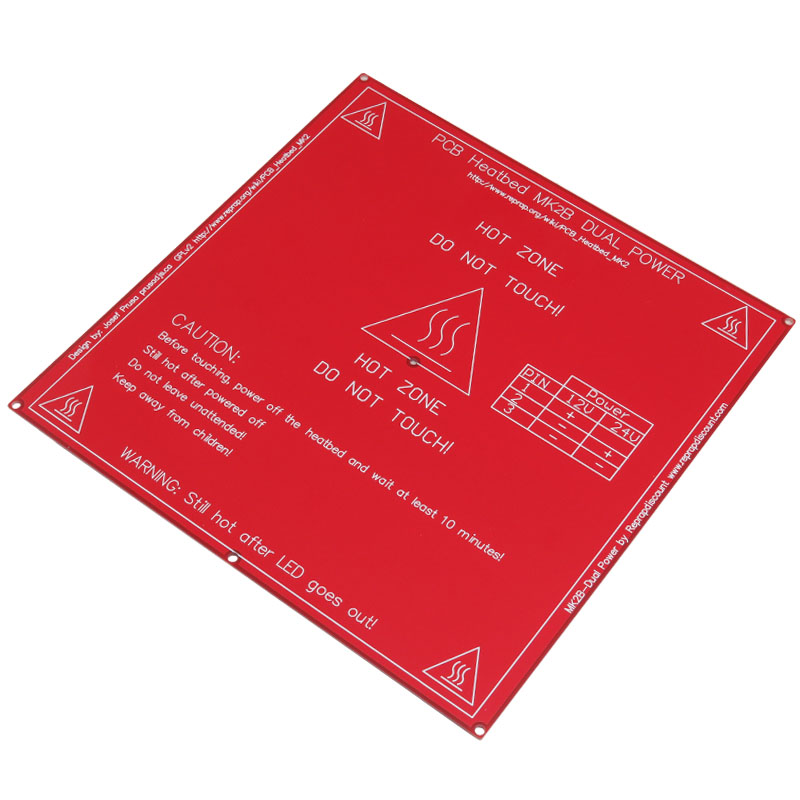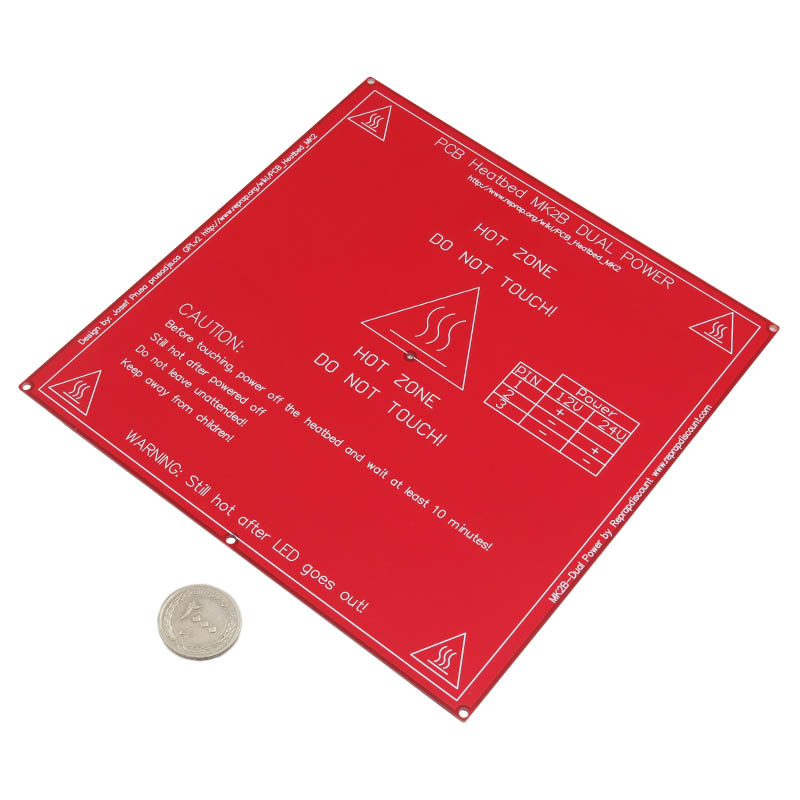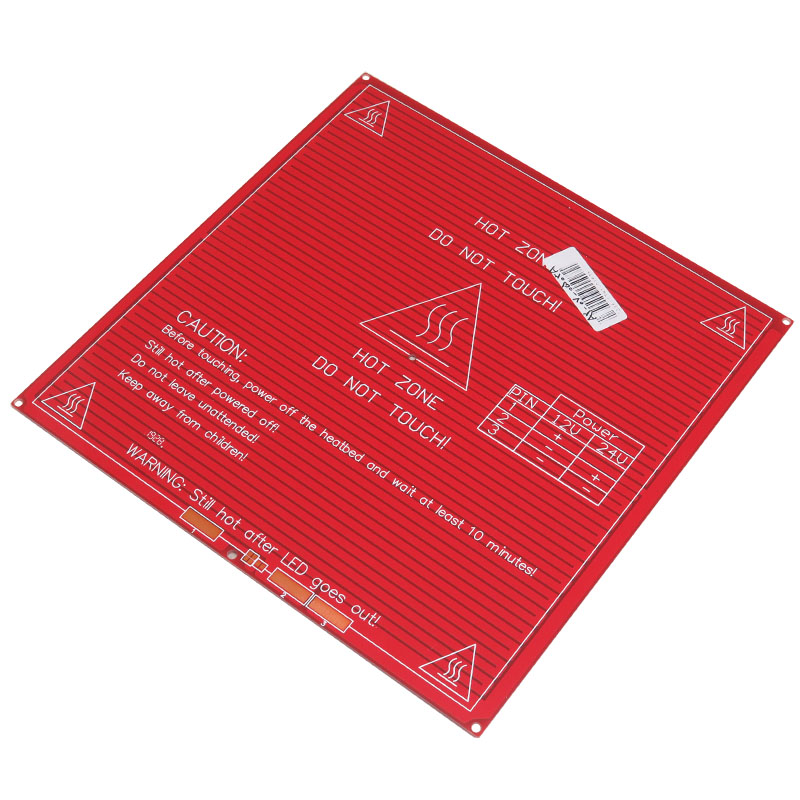موجودی در حال ارسال به انبار
-
100 عدد1404/07/12
4 از 5.0 با 13 رای
هیت بد پرینتر های سه بعدی RepRap مدل MK2B
* رنگ هیت بد ارسالی ممکن است قرمز یا مشکی باشد.
یکی از مسائل مهم در کار با پرینترهای سه بعدی، چسبیدن قطعه به صفحه زیرین در هنگام خشک شدن ماده پلاستیکی مذاب است که میتواند منجر به آسیب به قطعه چاپ شده هنگام برداشتن آن شود. برای حل این مشکل، استفاده از صفحههای گرم به عنوان هیت بد برای نگه داشتن دمای مناسب در ناحیه اتصال بین قطعه و بستر چاپ، ضروری است. هیت بد پرینتر سه بعدی RepRap مدل MK2B، با گرم نگه داشتن قطعه و ثابت نگه داشتن دمای آن، باعث میشود تا قطعه با بهترین کیفیت چاپ شده و از بروز تنشهای پس مانده ناشی از تفاوت دمای داخل و بیرون قطعه جلوگیری میکند. این صفحه داغ همچنین از ایجاد تغییرات شکل در قطعه جلوگیری کرده و کیفیت نهایی چاپ را بهبود میبخشد.
هیت بد MK2B از دو طرف ساخته شده است؛ یک طرف دارای خطوط مسی است که انتقال حرارت را بهینه میکند و طرف دیگر بدون خطوط مسی است. هر دو طرف صفحه دارای چاپ سیلک هستند که علاوه بر زیبایی ظاهری، در نصب «بالا به پایین» زیر لایه ای از شیشه نیز به عملکرد بهینه کمک میکند. این ویژگی به ویژه زمانی که از شیشه بهعنوان سطح چاپ استفاده میشود، مفید است. هیت بد RepRap از دو ولتاژ ۱۲ ولت و ۲۴ ولت پشتیبانی میکند، که امکان انتخاب ولتاژ مناسب با توجه به نیاز کاربر را فراهم میآورد.
این هیت بد دارای ساختار دو لایه مس با ضخامت ۳۵ میکرومتر است که باعث میشود گرمایش صفحه داغ سریع تر انجام شده و حرارت بهطور یکنواخت در سطح صفحه توزیع گردد. ابعاد بیرونی هیت بد ۲۱۴x۲۱۴ میلی متر است و ابعاد سطح داغ آن ۲۰۰x۲۰۰ میلی متر میباشد که با اکثر پرینترهای سه بعدی سازگاری دارد. لامینه این صفحه از جنس FR4 با ضخامت ۱.۶±۰.۱۵ میلیمتر است و در هر دو طرف آن ماسک لحیم قرمز استفاده شده است که دوام و عملکرد عالی آن را تضمین میکند.
در این مدل، نصب LED و مقاومت بهطور اختیاری است، اما در صورت استفاده از LED ها، باید مقاومت را نیز نصب کنید تا از آسیب به مدار جلوگیری شود. همچنین باید دقت داشته باشید که هنگام نصب هیت بد با شیشه به عنوان سطح ساخت، صفحه را با خطوط مسی به سمت بالا نصب کنید تا انتقال حرارت به شیشه بهینه شده و صفحه سریع تر گرم شود. این هیت بد بهویژه در پروژه هایی که نیاز به گرمایش یکنواخت دارند، عملکرد بسیار خوبی دارد و با استفاده از آن، پرینتر سه بعدی قادر به چاپ قطعات با دقت بالا و بدون انحراف خواهد بود.
کاربرد :
- جلوگیری از انحراف قطعات چاپی
- بهبود کیفیت چاپ با گرمایش یکنواخت
- مناسب برای استفاده با شیشه به عنوان سطح چاپ
- افزایش سرعت و کارایی در پرینترهای سه بعدی
مشخصات :
- ولتاژ ورودی: ۱۲ ولت یا ۲۴ ولت
- ابعاد کلی برد: ۲۱۴ × ۲۱۴ میلیمتر
- ابعاد سطح داغ (Heat Bed): ۲۰۰ × ۲۰۰ میلیمتر
- جنس لامینت: FR4 با ضخامت ۱.۶ ± ۰.۱۵ میلیمتر
- تعداد لایهها: ۲ لایه
- ضخامت مس: ۳۵ میکرومتر
- سوراخهای مسی پوششدار: دارد
- ماسک لحیم: قرمز در هر دو طرف
- چاپ سیلک: سفید در هر دو طرف
- مقاومت برد در ولتاژ ۱۲ ولت: بین ۱.۰ تا ۱.۲ اهم
- مقاومت برد در ولتاژ ۲۴ ولت: بین ۳.۰ تا ۳.۴ اهم
- توان مصرفی در ولتاژ ۱۲ ولت: حدود ۱۴۴ وات
- توان مصرفی در ولتاژ ۲۴ ولت: حدود ۱۴۴ وات
- نصب LED و مقاومت: اختیاری؛ در صورت استفاده، نصب مقاومت ضروری است
- سازگاری با پرینترهای RepRap: کاملاً سازگار
- نصب با شیشه بهعنوان سطح چاپ: توصیه میشود خطوط مسی به سمت بالا نصب شوند
- وزن تقریبی: حدود ۱۹۰ تا ۲۰۰ گرم
امکانات :
- قابلیت پشتیبانی از دو ولتاژ ۱۲ ولت و ۲۴ ولت
- گرمایش سریع و یکنواخت سطح چاپ
- نصب آسان با شیشه بهعنوان سطح ساخت
- ساختار دو لایه با مس ضخیم برای انتقال بهتر حرارت
The PCB still has a side with the traces on and a side without but now the silkscreen is on both the top and bottom, this makes it look good even when 'upside-down' under a layer of glass. The LED, resistor, and power wires can be mounted on either side of the board, with either surface mount or through-hole components. If you are using through-hole be careful when soldering not to interfere with the glass and introduce a gap between the glass and the PCB. If the MK2 board is made properly without copper plating then be sure to only solder the LED and resistor to the same side and the tracks. This problem is solved in the MK2a by removing the pads on the non-connected side. This heat bed keeps the extruded melted plastic and prevents warping. The LEDs are optional, but if you choose to use the LEDs you MUST install the resistor.
The PCB heat bed has two sides, one with the copper traces (bottom side) and one without (top). On older versions of the PCB heat bed, only the side without traces carried a silkscreen. Currently (as of January 2015) PCB heat beds are silkscreened on both sides.
Previously, printing on the top side was considered to be safer as the copper traces could be damaged if the print head would collide with the heat bed surface (if for example, the Z-min end stop malfunctioned). Obviously, if a piece of glass is used as the print surface, it protects the PCB copper traces. However, make sure your heat bed mounting springs are not too strong to prevent damage to the glass in case of an accidental collision.
Note that the LED, resistor and wire connections are also liable to accidentally collide with the print head.
when the PCB heat bed is used with a piece of glass as the build surface is to mount the PCB heat bed with the traces up. This improves heat transfer to the glass and the PCB heats up faster.
Features:
Dual Power: 12V or 24V
Fast Heat Up
Dimensions (Outer): 214 x 214mm
Dimensions (Heat Bed): 200 x 200mm
Laminate FR4 1.6±0.15mm
2 Layer, 35μm Copper
Copper Plated Holes
Red Solder mask both sides
White Silk screen both sides
Test report:
12V, with the increase of temperature, the current decline (physical knowledge: resistance increases with temperature change)
24V, the theoretical maximum current is less than 5A.


